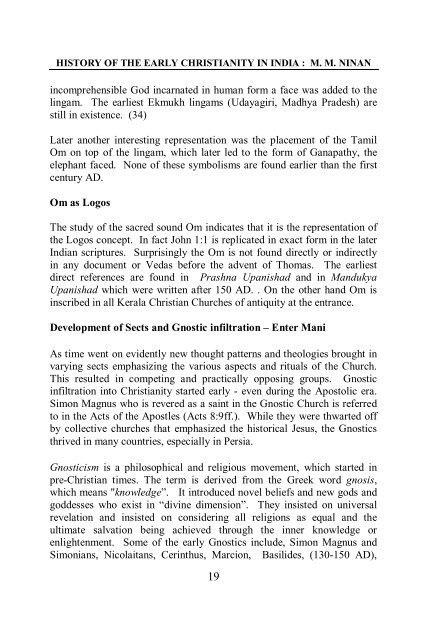History of Early Christianity in India
Create successful ePaper yourself
Turn your PDF publications into a flip-book with our unique Google optimized e-Paper software.
HISTORY OF THE EARLY CHRISTIANITY IN INDIA : M. M. NINAN<br />
<strong>in</strong>comprehensible God <strong>in</strong>carnated <strong>in</strong> human form a face was added to the<br />
l<strong>in</strong>gam. The earliest Ekmukh l<strong>in</strong>gams (Udayagiri, Madhya Pradesh) are<br />
still <strong>in</strong> existence. (34)<br />
Later another <strong>in</strong>terest<strong>in</strong>g representation was the placement <strong>of</strong> the Tamil<br />
Om on top <strong>of</strong> the l<strong>in</strong>gam, which later led to the form <strong>of</strong> Ganapathy, the<br />
elephant faced. None <strong>of</strong> these symbolisms are found earlier than the first<br />
century AD.<br />
Om as Logos<br />
The study <strong>of</strong> the sacred sound Om <strong>in</strong>dicates that it is the representation <strong>of</strong><br />
the Logos concept. In fact John 1:1 is replicated <strong>in</strong> exact form <strong>in</strong> the later<br />
<strong>India</strong>n scriptures. Surpris<strong>in</strong>gly the Om is not found directly or <strong>in</strong>directly<br />
<strong>in</strong> any document or Vedas before the advent <strong>of</strong> Thomas. The earliest<br />
direct references are found <strong>in</strong> Prashna Upanishad and <strong>in</strong> Mandukya<br />
Upanishad which were written after 150 AD. . On the other hand Om is<br />
<strong>in</strong>scribed <strong>in</strong> all Kerala Christian Churches <strong>of</strong> antiquity at the entrance.<br />
Development <strong>of</strong> Sects and Gnostic <strong>in</strong>filtration – Enter Mani<br />
As time went on evidently new thought patterns and theologies brought <strong>in</strong><br />
vary<strong>in</strong>g sects emphasiz<strong>in</strong>g the various aspects and rituals <strong>of</strong> the Church.<br />
This resulted <strong>in</strong> compet<strong>in</strong>g and practically oppos<strong>in</strong>g groups. Gnostic<br />
<strong>in</strong>filtration <strong>in</strong>to <strong>Christianity</strong> started early - even dur<strong>in</strong>g the Apostolic era.<br />
Simon Magnus who is revered as a sa<strong>in</strong>t <strong>in</strong> the Gnostic Church is referred<br />
to <strong>in</strong> the Acts <strong>of</strong> the Apostles (Acts 8:9ff.). While they were thwarted <strong>of</strong>f<br />
by collective churches that emphasized the historical Jesus, the Gnostics<br />
thrived <strong>in</strong> many countries, especially <strong>in</strong> Persia.<br />
Gnosticism is a philosophical and religious movement, which started <strong>in</strong><br />
pre-Christian times. The term is derived from the Greek word gnosis,<br />
which means "knowledge”. It <strong>in</strong>troduced novel beliefs and new gods and<br />
goddesses who exist <strong>in</strong> “div<strong>in</strong>e dimension”. They <strong>in</strong>sisted on universal<br />
revelation and <strong>in</strong>sisted on consider<strong>in</strong>g all religions as equal and the<br />
ultimate salvation be<strong>in</strong>g achieved through the <strong>in</strong>ner knowledge or<br />
enlightenment. Some <strong>of</strong> the early Gnostics <strong>in</strong>clude, Simon Magnus and<br />
Simonians, Nicolaitans, Cer<strong>in</strong>thus, Marcion, Basilides, (130-150 AD),<br />
19


















